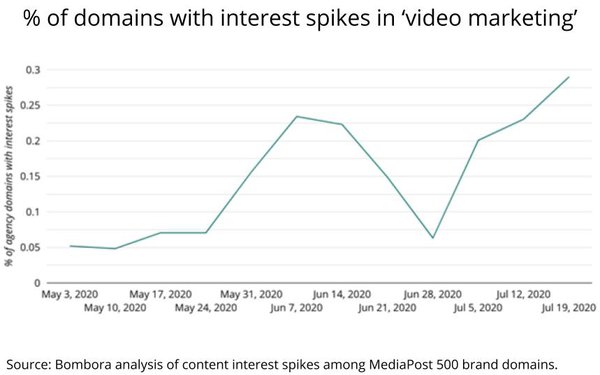
In last week’s column,
looked at how marketing and media industry content intent data indicated interest among brands and agencies in AI and its applications. We also saw renewed interest in outdoor advertising, painting a
picture of marketers attempts to reconcile the risks inherent in new technology with tried-and-true advertising mediums.
This week, we take a look at brands’ and agencies’ behaviors as they relate to a few common marketing tactics and mediums. What does this
data mean in relation to an impending election and four months of a workforce mired in a public health crisis?
- “Brand Safety” took a nose dive late June as online
publishing platforms continue to take the necessary steps to appease advertiser’s concerns. However, with the 2020 U.S. presidential election looming, and an influx of political content and ad
dollars, we are bound to see new brand safety opportunities and challenges that will inevitably impact commercial advertisers online. This also comes at a time when brand safety concerns are being
felt more broadly as channels beyond social media undergo digitization requiring new guidance.
- Video consumption
continues to grow rapidly worldwide in recent months. When compared to another marketing activities, both brands and agencies are focusing their efforts on “Online Video Marketing.”
Whether you are using video for remote learning, interacting with colleagues or replaying a keynote speech from an industry trade show – video is chosen by people worldwide as their main means
of staying connected and informed. As marketers, we have always understood the many benefits of video. However, in this moment, video has become one of the most important tactics in the
marketer’s toolbox -- powering attention-grabbing, customer-centric, brand-safe and result-driven experiences.
- “Streaming Media” also began surging among
brands in mid-May, declined a bit mid-June, and saw a steep rise again last week. Streaming media can refer to video or audio, and interest around this term makes sense, given that it includes online
video. Over-the-top (OTT) advertising slots into this category; Hulu announced its plans to roll out a self-serve advertising tool, aiming to attract more small and medium sized businesses who wish to
advertise on its platform.
- Advertisers will be glad to know that increased digital marketing opportunities,
such as “Online Video” and “Podcasting,” haven't totally replaced print marketing. In fact, we are seeing growing interest in “Multichannel Marketing” and
“Print Collateral.” Done well, print and digital offer unique ways to be integrated. Print can still play an integral role in marketing for almost any company. When people touch, hold, and
even smell paper, they respond in a profoundly personal way. As more people feel comfortable with receiving mail to their homes (vs the office) – brands and their agencies may have a unique
opportunity to create an entirely new experience that builds engagement and leaves a tangible impression.
advertisement
advertisement